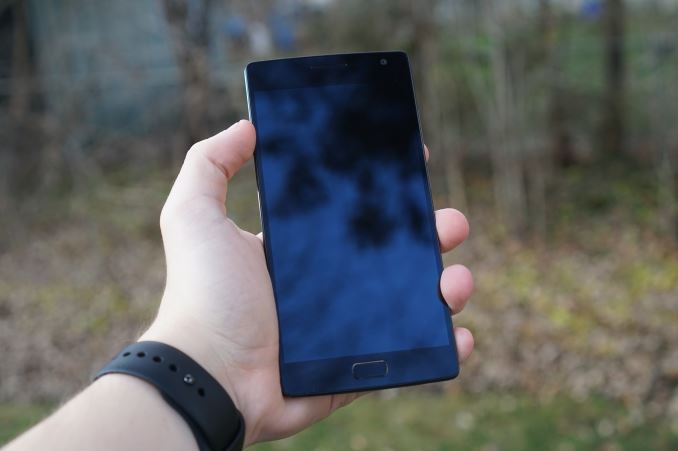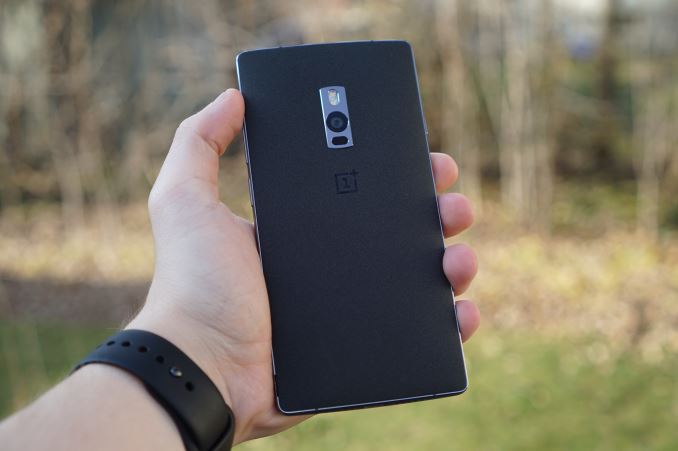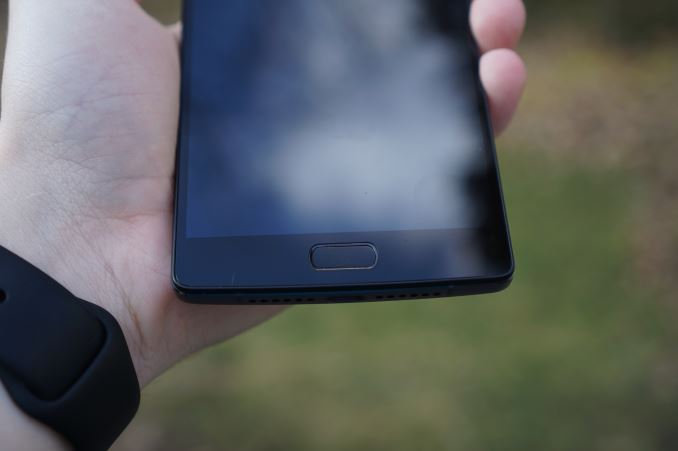The OnePlus 2 Review
by Brandon Chester on December 14, 2015 8:00 AM EST- Posted in
- Smartphones
- Mobile
- OnePlus
- OnePlus 2

In early 2014, there was a lot of excitement among Android enthusiasts for an upcoming smartphone called the OnePlus One. The company producing it was a Chinese manufacturer, and they were a new entrant to the smartphone space. OnePlus's marketing campaign was structured to generate excitement over the prospect of receiving similar specifications to a high end smartphone in a device that was priced substantially lower. Once the device launched, it was clear that OnePlus had delivered on that promise in many respects. The performance and display quality were superb for a $300-350 device, but parts of the software and the camera processing were somewhat lacking.
While the OnePlus One wasn't perfect, there really aren't any smartphones that are. For $300-350, it certainly offered users shopping on a budget a lot of power for their money. With many aspects of the phone already being executed well, one would expect that OnePlus's next phone would serve to iron out the issues and improve on some of the original's failings. That brings us to 2015, with the OnePlus 2 serving as the next flagship smartphone from OnePlus. In many ways it's similar to its predecessor, but with over a year between releases, and a change from CyanogenMod to OnePlus's Oxygen OS, there are certainly a number of changes as well. You can view a comparison of the OnePlus One and OnePlus 2 in the chart below.
| OnePlus One | OnePlus 2 | |
| SoC | Snapdragon 801 2.5 GHz Krait | Snapdragon 810 1.8 GHz A57/A53 |
| RAM | 3GB LPDDR3 | 3/4GB LPDDR4-1555 |
| NAND | 16/64GB NAND | 16/64GB NAND |
| Display | 5.5” 1080p IPS |
5.5” 1080p IPS |
| Network | 2G / 3G / 4G LTE (Category 4 LTE) | 2G / 3G / 4G LTE (Category 6/9 LTE) |
| Dimensions | 152.9 x 75.9 x 8.9mm, 162g | 151.8 x 74.9 x 9.85mm, 175g |
| Camera | 13MP Rear Facing (Sony IMX214) f/2.0, 1.1 micron 1/3.06" sensor | 13MP Rear Facing w/ OIS and laser AF, f/2.0, 1.3 micron 1/2.6" sensor |
| 5MP Front Facing | 5MP Front Facing | |
| Battery | 3200 mAh (12.16 Whr) | 3300 mAh (12.54 Whr) |
| OS | Android 4.4 w/ CM11S (At Launch) | Android 5.1 w/ OxygenOS (At Launch) |
| Connectivity | 1x1 802.11a/b/g/n/ac + BT 4.0 (WCN3680), USB2.0, GPS/GNSS, NFC |
802.11a/b/g/n/ac + BT 4.1, (QCA6164A) USB-C, GPS/GNSS |
| Fingerprint Sensor | N/A | Touch |
| SIM | 1x MicroSIM | DSDS NanoSIM |
| LTE Bands | Global: 1/3/4/7/17/38/40 | US: 1/2/4/5/7/8/12/17 EU: 1/3/5/7/8/20 |
| Launch Price | $299 (3GB/16GB) $349 (3GB/64GB) |
$329 (3GB/16GB) $389 (4GB/64GB) |
When looking at the specs of the OnePlus 2 one can definitely see a similarity between it and the OnePlus One. Both devices have 5.5" 1080p IPS displays, come with either 16 or 64GB of NAND, have a 13MP rear-facing camera with OIS, and ship with Qualcomm's latest SoC. In the case of the OnePlus 2, the SoC moves from Snapdragon 801 to 810, and with that we see a move to LPDDR4 DRAM along with an additional gigabyte of RAM in tow on the 64GB model. The battery capacity receives a slight bump as well, but this is also accompanied by an increase in mass and thickness. The camera sensor has been increased in size, from a 1/3.06" format to a 1/2.6" format. As for the other changes, there's improvement to both cellular and WiFi networking, the inclusion of a fingerprint scanner, and of course, a $30/40 increase in starting price for the 16/64GB models respectively.
Design
The OnePlus One had some unique design attributes that allowed it to stand out from the other devices on the market. Probably the most significant was the back cover, which sported a highly textured feel which one could describe as being like a very fine type of sandpaper. The OnePlus 2 retains many of these traits, but also adds to the design in other ways such as the use of metal for the frame around the device instead of plastic.
Starting with the back cover, you get the same sandpaper-like finish as the OnePlus One. The back cover is actually removable, but it's fit extremely well to the back of the device so you don't get highly visible seams. This means that it is a bit difficult to remove, and I had to slide a sim ejector between the one visible gap in order to start prying it off. While it is connected very tightly, the use of little plastic tabs to hold it on makes me a bit concerned about longevity if you remove the back cover too many times. The Galaxy Nexus used a similar mounting system and I recall seeing phones where one or two of the tabs had broken off which prevented it from attaching properly.
One you remove the back cover you'll see that you don't actually get a removable battery. This isn't any different from the OnePlus One, but I've never really understood the point of having a removable back that only serves to access the SIM tray, when you could just make the sim tray accessible from one of the edges of the device. Since the OnePlus 2 is a dual-SIM phone you also get an interesting little SIM tray which holds both SIM cards. I personally don't have much use for the dual-SIM feature, but I know there are certain (and major) markets where it's absolutely essential so it makes a great deal of sense for OnePlus to include it.
As for the appearance and feel of the back of the phone, I'm honestly not a huge fan. For me the textured back is interesting, but it's not really very pleasing to hold in the hand, and there's just something about how my palm rubs against it that gives me shivers. The little island for the camera, flash, and IR sensor also hasn't been designed with much thought. Considering the flash and IR sensor are almost the same size, I don't understand why OnePlus decided to put them in different orientations instead of making the entire arrangement symmetrical in its appearance. Something about the lack of edge space on the sides of the camera lens looks a bit off as well, although I find it difficult to articulate exactly why it seems that way.
On the bottom of the phone you'll find a set of drilled holes with a USB Type-C port sitting between them. I've said this in all of my other reviews of devices that use USB Type-C, but the transition has to happen eventually and while it's unfortunate that you won't be able to use existing Micro-B cables, it's worth it in the end.
Looking at the other sides of the phone one will see that the right side is home to the sleep/wake button and the volume rocker, while the left has a 3 stage mute switch. The three positions correspond to the three settings for Android notifications, and it's interesting that only OnePlus and Apple include a hardware switch to switch the mute status on their phones. The top of the phone is fairly featureless, aside from a 3.5mm audio jack.
Moving on to the front of the phone we find that it's dominated by the display, with minimal bezel on the top and bottom. Despite this, OnePlus has managed to implement capacitive buttons, a fingerprint scanner, and all without having to move the USB port such that it would be misaligned. The capacitive keys don't have any icons apart from an illuminated horizontal line, but by default they follow the same layout as the standard on screen keys that you'd find on other phones. On the top you have the earpiece and the front facing camera.
In the end, I think from a fit and finish standpoint the OnePlus 2 is actually a pretty good device. It does feel solid in the hand, there's no gaps or flex between the back cover and the rest of the phone due to how it attaches within the edges of the frame instead of onto them, and overall it just feels like a sturdy and substantial phone. As for the design, there are definitely some questionable choices that have been made such as the camera island on the back, and I am definitely not a fan of the back cover material. It's certainly unique though, and if you don't mind the back cover material you'll be getting a pretty solidly built device with the OnePlus 2.













132 Comments
View All Comments
Allan_Hundeboll - Wednesday, December 16, 2015 - link
Some info in this review is wrong. OnePlus One do not have OIS but it does have a metal frame.jabber - Wednesday, December 16, 2015 - link
I was going to get the One Plus 2 but waited so long for an invite I just gave up and went on Amazon and bought a LG G4.The invite appeared the next day. I kind of thought it would. Too late guys. You lost a sale.
I do not regret getting the G4. Great phone.
gg555 - Sunday, December 20, 2015 - link
This review demonstrates everything that I've always thought about OnePlus. It's all hype over substance.They do not make flagship phones (let alone flagship killers). They put a couple high end features in the phone, cut corners in many other places, try to distract and dazzle you with the high end features, and then sell you essentially a mid-range phone at a mid-range price, which is exactly what you should expect for the money.
They also have engineering issues and not so great quality control. How they can have taken the already hobbled Snapdragon 810 and reduced it's performance even more, to the level of a budget phone like a Moto E (as the review says) is beyond comprehension. But still, they made a whole big promise about how they'd handled the 810s heat issues. Handled it by making the chipset worse than far inferior chipsets.
If this is your budget range, you're far better off with a Moto X, which is a truly nice phone.
p51d007 - Tuesday, December 22, 2015 - link
Not to mention out right LIES."First to have a USB-C port"....yeah, the plug & jack are "USB-C" like, but the PORT itself is still USB-2. No support, buggy software, ghost touches.
The X is a MUCH better phone. If you really really have your heart set on the 2 (personally, I'd pass), wait a few months for them to eventually work out the bugs. The OnePlus One is now not really a bad phone, but it took them nearly a year to get most of the bugs out.
OnePlus, is nothing but the beta tester for Oppo. Every OnePlus phone, has a Oppo version that comes out later. The Oppo Find9, was SUPPOSE to be out at the end of this year, but feedback from the suckers who bought the OnePlus2, about the glitches with the overheating/underclocking, they've DELAYED the Find9 until next year and it will come out with the SD820 chip, NOT the 810 chip.
UtilityMax - Saturday, December 26, 2015 - link
I have OPO since February, and it had been running pretty smooth. Fantastic smartphone for the money. Even today, it sort of makes sense given the price dropped $50 to $300 for 64GB version. One amazing thing about it is not just the great screen, camera and battery life, but also the reception. I must be living in an area with a sh1tty LTE coverage since all of our other smartphones work barely faster than 3GB (including iPhones), but the OPO, zOMG! The signal is like 10dbm better at all times, which results in very nice data benchmarks often slaughtering the broadband connection I have (used to be 20Mbps, now 40Mbps with Oneplus One getting that much over LTE)UtilityMax - Saturday, December 26, 2015 - link
I'd disagree with your comment. Both the OnePlus One and OnePlus X were a home run, but with a few small reservations. OnePlus One was well rounded and was at least 90% as good as any flagship phone, but sold for about half the typical price. Even today the 64GB Oneplus One probably remains the best $300 (with a few reservations, such as the store shows they're out of stock). And Oneplus X is basically a Oneplus One, but in a form factor and build quality that really should have been in Oneplus Two, and at $250 in the US, again it's one of the best phone for that price. The Oneplus Two may have its issues, but guess what.. all of the current crop of Android phones using Snapdragon 64-bit 808/810 SoCs have those issues.Ashwith - Friday, December 25, 2015 - link
Seems like the reviewer does not have much experience in reviewing nor regarding smartphone. These days we get to see reviewers dime a dozen and sadly most of them sucks like this one. There is no phone which is perfect and oneplus 2 has its list of cons which are many. But for the prize of $389/- it will give a stiff challenge to all other phones in that range. Only when you use 5X you will get to see that it does not stand a chance with Oneplus 2 and along with goes the credibility of this reviewer. S6 on the other hand does better in all departments. Cheers!UtilityMax - Saturday, December 26, 2015 - link
One great alternative is still the old good Oneplus One. Sold for 250/300 for the 16GB/64GB version respectively. Even today, it's still probably the best $300 smartphone, which is a testament to how well it was made. The only issue though is that it's out of stock at oneplus store...blzd - Friday, January 1, 2016 - link
Your experience reviewing and regarding smartphones is clearly inferior to that of the reviewers. Maybe one day you'll review a smartphone and not just try and justify your purchase decisions. Cheers!Cloudane - Sunday, January 31, 2016 - link
Yikes... what a slating. I just ordered one of these having seen other reviews and thinking they were good, starting to wonder about cancelling my order now :(